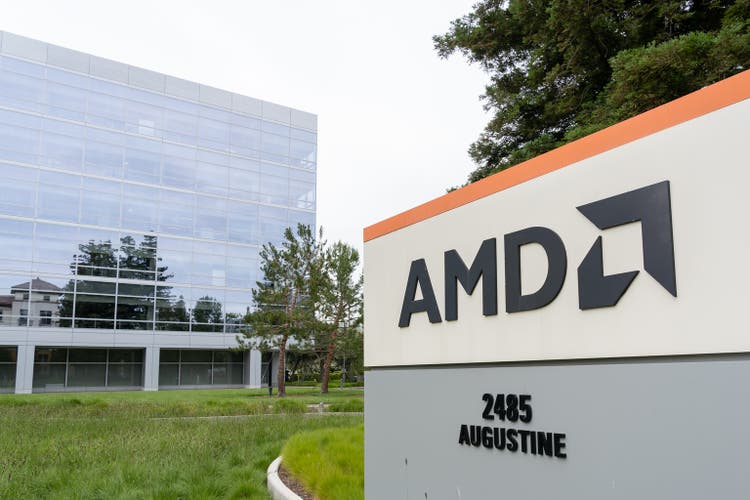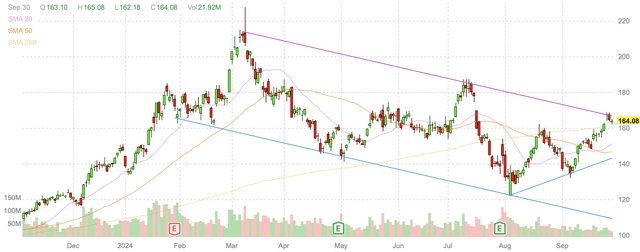Summary:
- AMD is poised for a potential breakout from its current trading range, driven by strong Q2 earnings and robust Data Center revenue growth.
- The acquisition of ZT Systems enhances AMD’s AI and data center capabilities, potentially boosting revenue and market position.
- Risks include failing to break resistance at $160 and negative analyst sentiment regarding the ZT Systems acquisition or data center guidance when it reports Q3 earnings later this month.
- A breakout could see AMD testing $180-$200, while failure to break out may see shares fall to the low $140s.
JHVEPhoto
Advanced Micro Devices, Inc. (NASDAQ:AMD) (NEOE:AMD:CA) once again looks like it is ready to break out of its recent trading range. The company has been stuck in a declining trading range since this spring, but I believe that this range is likely a large bull flag out of which the company is on the verge of breaking out, and spiking higher. Simultaneously, if AMD is incapable of breaking out of this range soon, shares are likely to reverse lower.
AMD daily candlestick chart (FINVIZ.com)
Over the summer, AMD and many other semiconductor and AI related equities declined and made bottoms in early August. At that time, AMD also reached the bottom of its trading range. This also coincided with the broader market putting in its recent low. Since then, AMD has substantially appreciated, and it is now back to the top of this recent trading range. Therefore, it appears possible that AMD is potentially ready to break out of this range and gap higher.
At the end of July, AMD reported second quarter 2024 earnings that beat estimates. The beat was due to multiple factors, including record Data Center segment revenue. AMD’s second quarter revenue came in at $5.84 billion, beating consensus estimates by about $120 million, and non-GAAP earnings of $0.69 per share were slightly better than the $0.68 estimate.
As part of its earnings, AMD CEO Lisa Su commented that
“Our AI business continued accelerating, and we are well positioned to deliver strong revenue growth in the second half of the year, led by demand for Instinct, EPYC and Ryzen processors.”
Data Center revenue growth was about 115 percent higher than the same quarter last year. Second quarter Data Center revenue came in at a record $2.8 billion. Moreover, AMD’s Client segment revenue was $1.5 billion, which was a year-over-year increase of 50 percent.
AMD did have some weaker segments. AMD’s Gaming segment was down 59 percent year-over-year to $648 million. This decline was primarily attributed to declining semi-custom sales. AMD’s Embedded segment also declined, with about $861 million in revenue, which was down 41 percent compared to the same quarter last year.
AMD provided Q3 2024 guidance expecting total revenue of $6.7 billion. This guidance was an increase and higher than the consensus Wall Street analyst estimates for revenue of about $6.6 billion.
In August, AMD reported that it would acquire ZT Systems, an AI infrastructure provider, in a cash and stock deal worth about $4.9 billion. The transaction also includes a contingent payment that may be worth up to $400 million, based upon reaching certain post-closing milestones. Thus far, this deal has not had any regulatory scrutiny, and it appears unlikely that it should receive any.
The acquisition of ZT Systems should help AMD expand its data center and AI systems capabilities. Moreover, this acquisition immediately provides AMD with existing AI revenue from its operations that AMD can add to its reporting. This should give AMD a highly desirable data point to tout in its earnings reports after completing the acquisition. The acquisition is expected to close in the first half of 2025.
AMD CEO Lisa Su noted that
“Combining our high-performance Instinct AI accelerator, EPYC CPU, and networking product portfolios with ZT Systems’ industry-leading data center systems expertise will enable AMD to deliver end-to-end data center AI infrastructure at scale with our ecosystem of OEM and ODM partners.”
ZT systems also owns a domestic data center infrastructure manufacturing business that AMD intends to divest upon finding a strategic partner. While it is unclear what price AMD may be able to command for this business, it may end up being significant, and also has the potential to increase in value between now and the closing of the transaction. Given the recent growth in data center development, the business should be wanted by at least a few suitors, and that could result in a bidding war.
There are reasons to expect AMD to remain competitive. AMD has a history of remaining in tough competition with Intel (INTC) in the development of personal computing chips. Since at least mid-2020, AMD took a lead in that race, when Intel was forced to report a delay to its 7nm product due to a defect, or defects, in the process. When Intel made that announcement, AMD had already brought a 7nm product to the marketplace, and has more recently brought to market a 4nm product. While it is not certain that AMD is expanding their lead, they may be, or at the least appear to be maintaining it.
AMD is now the second horse in the A.I. chip race, where NVIDIA (NVDA) maintains a sizable lead in both technology and market share. It is possible they will one day catch up to NVDA, or at least take a significant share of the growing market by offering reasonably competitive products at a lower price point. This could mimic how AMD initially lagged Intel’s PC chips in performance, but was able to catch up and eventually surpass them.
AMD chips are also surprisingly competitive in cryptocurrency mining. AMD’s most recent version of the Ryzen 9 is among the better performing chips at its price point for solving the algorithms at the heart of cryptocurrency mining. The competitiveness of AMD’s CPU chips towards these specific tasks is not the norm, as it is typically handled by GPUs, such as graphics cards, and application-specific integrated circuits (or ASICs) that may be considered specialists designed to only perform that function.
AMD’s recent performance in August and September has taken shares back to the high-point of its recent trading range. This should be a resistance point, but if AMD can break through here, it could also subsequently act as a level of support. Moreover, the last time it made it through this current level and climbed higher than the low $160s was in the first half of July, when AMD quickly moved up to the low $180s. Such a move is possible on a breakout of this trading range.
A similar breakout also occurred in March, where AMD shares briefly went above $200, but then broke down and started its recent downtrend. A breakout here could result in a strong move where AMD returns to those 2024 highs.
One potential near term catalyst could come in the form of analyst revisions after AMD reports its quarterly earnings in about a month (AMD is expected to report on October 29). Those revisions could be premised upon a revenue beat, or merely AMD’s continuing data center performance. Further, AMD is likely to provide some more details around the ZT Systems acquisition, which may be integrated into revenue models and increase analyst estimates for late 2025 and 2026 revenue. Since the acquisition brings with it existing revenue streams, AMD should already be expected to realize an increase to its revenue once adding ZT Systems’ business into AMD.
Risks
The most apparent risks facing AMD bouncing off this resistance point in the low $160s and falling back towards the bottom of its trading range. Beyond just failing at resistance due to AMD’s valuation, it is also possible that a broad market selloff would take AMD down along with it. If AMD were to fail in breaking out of this resistance point, it is possible that shares could fall to the low $140s, where there appears to be some level of support.
Another risk is that analysts dislike the answers to questions regarding the ZT Systems acquisition, or data center guidance that is to be provided during AMD’s post-earnings conference call. Any such change in analyst sentiment would likely act like an anchor to share pricing, and make it more difficult for AMD to move considerably higher.
Conclusion
AMD is one of a select few equities that are likely to be long-term beneficiaries of growth in A.I. and cryptocurrency. AMD also has the potential to benefit from a PC refresh cycle that may occur. AMD has underperformed the market in 2024, since spiking to overbought this spring, but a breakout of the company’s downtrend would indicate a high probability of gapping higher into the end of the year, and potentially testing the spring high AMD made in March.
AMD performed exceedingly through August and September, and is now back to the top of its trading rage. Any move higher is likely to result in a breakout of an apparent bull flag, where AMD could test $180 or even $200 on a strong Q3 2024 earnings report and increased guidance that compels analysts to raise their targets. Simultaneously, a failure to break out here would indicate AMD is still stuck in this trading range.
Analyst’s Disclosure: I/we have no stock, option or similar derivative position in any of the companies mentioned, but may initiate a beneficial Long position through a purchase of the stock, or the purchase of call options or similar derivatives in AMD over the next 72 hours. I wrote this article myself, and it expresses my own opinions. I am not receiving compensation for it (other than from Seeking Alpha). I have no business relationship with any company whose stock is mentioned in this article.
Seeking Alpha’s Disclosure: Past performance is no guarantee of future results. No recommendation or advice is being given as to whether any investment is suitable for a particular investor. Any views or opinions expressed above may not reflect those of Seeking Alpha as a whole. Seeking Alpha is not a licensed securities dealer, broker or US investment adviser or investment bank. Our analysts are third party authors that include both professional investors and individual investors who may not be licensed or certified by any institute or regulatory body.
